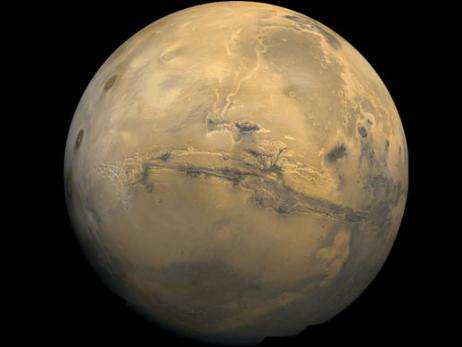Summary: Never previously in modern human history has Mars been as bright or as close to Earth as tonight. Look for it in the night sky, as it will be easily recognized by its red tinge. As with all planets, its light will also stand out from the background of stars, because it will not appear to flicker, but instead looks like a steady, bright object. An amateur's four-inch telescope may reveal the polar cap and some surface features.

Image courtesy of Nasa
NASA: The largest canyon in the Solar System cuts a wide swath across the face of Mars. Named Valles Marineris, the grand valley extends over 3,000 kilometers long, spans as much as 600 kilometers across, and delves as much as 8 kilometers deep. By comparison, the Earth's Grand Canyon in Arizona, USA is 800 kilometers long, 30 kilometers across, and 1.8 kilometers deep. The origin of the Valles Marineris remains unknown, although a leading hypothesis holds that it started as a crack billions of years ago as the planet cooled. Recently, several geologic processes have been identified in the canyon. The above mosaic was created from over 100 images of Mars taken by Viking Orbiters in the 1970s. Photo Credit: Viking Project.
The latest Mars rover, Opportunity, launched July 7th, and its sister rover, Spirit, which was launched on June 10th, have begun challenging trips to act as robotic geologists. The twin launches began journeys leading to an eventual three months of exploration on the martian surface in January. To help scientists determine whether there was ever enough water on Mars to sustain life, the motorized explorers will send back images of sediment and mineral deposits.
A primary reason for this summer flurry of Mars missions is a unique close approach between Earth and Mars. Mars is approaching Earth in what is the closest the planets have been in 73,000 years--a confluence set officially for 5:46 AM, Wednesday, August 27, 2003. Tonight, the Red Planet will be the brightest object in the sky as it reaches its closest Earth encounter, or opposition, at 34,646,418 miles.



 Ian Powell: Physician Associates - A ‘Solution’ Desperately Searching For A Problem
Ian Powell: Physician Associates - A ‘Solution’ Desperately Searching For A Problem Binoy Kampmark: Natural Resources And Palestinian Sovereignty - Israel’s Further Isolation
Binoy Kampmark: Natural Resources And Palestinian Sovereignty - Israel’s Further Isolation Martin LeFevre - Meditations: What Being “Inward Looking” Really Means
Martin LeFevre - Meditations: What Being “Inward Looking” Really Means Binoy Kampmark: Blinken Atrocious In A Dangerous World
Binoy Kampmark: Blinken Atrocious In A Dangerous World Jim Mikoz: Look Out Rocks … Oops Too Late
Jim Mikoz: Look Out Rocks … Oops Too Late Peter Dunne: Dunne’s Weekly - National And Labour Combine To Shut Out Greens
Peter Dunne: Dunne’s Weekly - National And Labour Combine To Shut Out Greens